Lithium batteries or lithium-ion batteries
Lithium battery is a new high-energy battery developed in the 20th century. It can be broadly classified into two categories: lithium primary batteries and lithium-ion batteries. Primary lithium batteries, which are non-rechargeable, often use lithium metal or lithium compounds as the anode material, like button batteries. Lithium-ion batteries, which are chargeable, use lithium-ions as the charge carriers, moving them between the anode and the cathode during charge and discharge cycles. Colloquially, people often use "lithium battery" to refer specifically to lithium-ion batteries due to their prevalence and popularity in modern devices. Therefore, the following article will focus on lithium-ion batteries.

The structure of lithium-ion batteries
Understanding the structure of lithium batteries is crucial to comprehending how they work. The basic structure of a lithium-ion battery consists of several key components:
Cathode
Usually contains lithium compounds such as lithium iron phosphate (LiFePO4) or lithium cobalt oxide (LiCoO2).
Anode
Typically made of non-lithium elements like graphite or silicon.
Separator
A polymer membrane with a micro-porous structure, allowing lithium-ions to pass through while blocking the flow of electrons.
Electrolyte
Usually an organic substance that enables the free movement of lithium-ions.
Battery Casing
Typically an enclosure that wraps around the aforementioned components, forming various shapes such as square or cylindrical batteries.
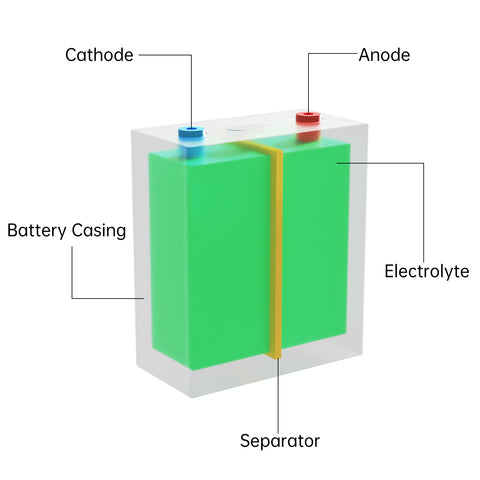
Working Principles of Lithium-ion Batteries
Having understood the structure of Lithium-ion Batteries, we can now delve into their working principles.
Charging
During the charging process, lithium ions are extracted from the lithium compound in the positive electrode. These lithium ions move through the electrolyte to the negative electrode, embedding themselves into the micro-holes of the negative electrode material.
Discharging
During the discharging process (when the battery is in use), lithium ions embedded in the negative electrode carbon layer move back to the positive electrode. The more lithium ions return to the positive electrode, the higher the discharge capacity. The commonly referred battery capacity is essentially the discharge capacity.
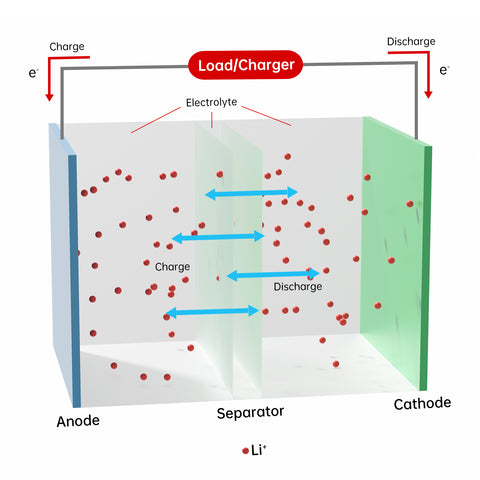
Classification of lithium-ion batteries
The classification of lithium-ion batteries can be based on several factors, including the type of materials used in the electrodes, electrolyte, appearance, and specific applications. Here is a classification of lithium-ion batteries based on various criteria:
By Positive Electrode Material
-
Monovalent (One Element):
- Lithium Iron Phosphate (LFP)
- Lithium Cobalt Oxide (LCO)
- Lithium Manganese Oxide (LMO)
-
Divalent (Two Elements):
- Nickel Manganese Lithium
- Nickel Cobalt Lithium
-
Trivalent (Three Elements):
- Nickel Cobalt Manganese Lithium (NCM)
- Nickel Cobalt Aluminum Lithium (NCA)
By Negative Electrode Material
- Lithium Titanate (LTO)
- Graphene Batteries
- Nanocarbon Fiber Batteries
By Electrolyte Material
- Liquid Lithium-Ion Batteries (LIB)
- Polymer Lithium-Ion Batteries (PLB)
By Appearance
- Cylindrical Lithium Batteries
- Pouch Lithium Batteries
- Square Lithium Batteries
By Application
-
Power Batteries:
- Electric vehicles
- Electric bikes
- Power tools
-
Energy Storage Batteries:
- Stationary energy storage systems for homes
- Businesses
- Grid-level applications
-
Consumer Electronics Batteries:
- Smartphones
- Laptops
- Cameras
-
Wearables
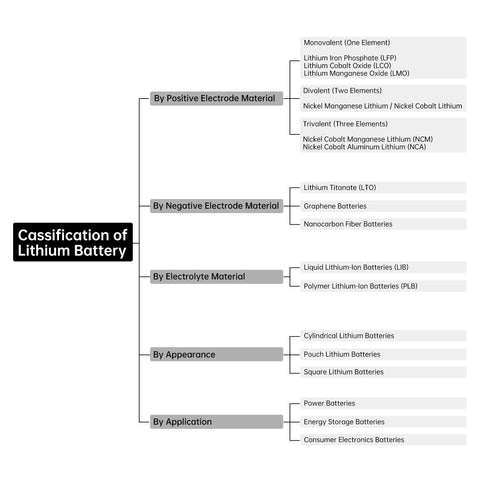
Advantages of Lithium-ion Batteries
Energy density
Energy density refers to the amount of energy that can be stored in the battery per unit of volume or weight. This characteristic of lithium-ion batteries enables EVs to travel longer distances on a single charge compared to other types of batteries. It also means higher space efficiency, which is beneficial for homeowners who may have limited space for energy storage systems.
High voltage
High voltage in lithium batteries refers to the elevated electrical potential or voltage provided by these batteries during operation. Lithium batteries typically operate at higher voltage levels compared to other types of batteries. For example, lithium-ion batteries commonly have a nominal voltage of 3.7 volts per cell, providing higher power output, which aligns well with the requirements of smartphones and cameras.
No memory effect
If you've ever used batteries like nickel-cadmium (NiCd) batteries, you may find that batteries seem to "remember" its charge capacity and become unable to deliver the full capacity if it is not discharged fully before recharging. However, without memory effect, you can recharge a lithium battery at any state of charge, and it will not "remember" the previous charge cycles.
Low self-discharge rate
Lithium batteries exhibit a low self-discharge rate, meaning they lose less of their stored energy when idle. This is advantageous for devices that may remain unused for extended periods without significant loss of battery capacity.
Long cycle life
Long cycle life refers to the number of charge and discharge cycles a battery can undergo while maintaining acceptable performance. lithium-ion batteries, have a long cycle life, allowing them to endure numerous charge and discharge cycles. This is crucial for applications requiring sustained and repeated use, such as electric vehicles (EVs) and renewable energy systems.
Environmentally friendly
Lithium batteries are considered more environmentally friendly than some alternatives. Regardless of production, use and recycle, it does not contain or produce any toxic and harmful heavy metal elements and substances such as lead, mercury and cadmium. At the same time, the lithium, nickel, cobalt and other elements recovered from discarded lithium batteries can be reused to manufacture new batteries, reducing the environmental burden.
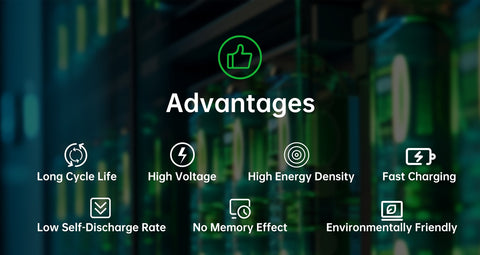
Disadvantages of Lithium-ion Batteries
Safety Concerns
Lithium-ion batteries may encounter issues such as overheating, short circuits, or explosions in abnormal conditions. However, in terms of the material itself, lithium manganese oxide (LMO) and lithium iron phosphate (LFP) batteries exhibit stronger stability, with a significantly lower risk of ignition compared to ternary lithium batteries. Therefore, from a safety perspective, lithium manganese oxide and lithium iron phosphate batteries are relatively more stable.
Overcharge and Overdischarge
Overcharging and overdischarging can lead to the decomposition of internal components in lithium batteries, rendering them unrecoverable. Hence, lithium-ion batteries require protective circuits to prevent overcharging. The installation of a Battery Management System (BMS) is essential to monitor and ensure safety. If a lithium-ion battery is subjected to overcharging, it can cause the electrolyte to break down, resulting in gas release and potential thermal runaway.
High Costs
The production cost of lithium batteries is high due to expensive materials and stringent manufacturing requirements. Additionally, consumers may face higher purchasing costs. The demand for materials like lithium, cobalt, and nickel, coupled with advanced manufacturing processes, contributes to the elevated cost of lithium batteries for manufacturers and end-users alike.
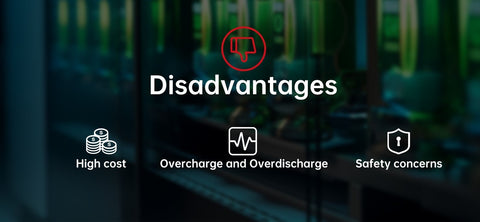
Development status and future trend
Due to its excellent performance, lithium ion batteries are widely used in three major scenarios: power, energy storage, and consumer applications, with vast development prospects.
- Power lithium batteries are primarily used in electric vehicles, electric bicycles, electric tools, etc.
- Energy storage lithium batteries find their main applications in scenarios such as communication base stations, home energy storage, and off-grid power stations.
-
Consumer lithium batteries are mainly applied in consumer electronic products such as mobile phones, laptops, as well as emerging devices like Bluetooth headphones and wearable devices.

Conclusion
Lithium batteries refer to batteries with lithium-containing positive electrodes and can be divided into lithium primary batteries (non-rechargeable batteries) and lithium-ion batteries (rechargeable batteries). Lithium-ion batteries have various characteristics such as high energy density, high voltage, low self-discharge rate, long cycle life, and environmental friendliness. However, they also have disadvantages, including safety concerns and high costs. With the development of lithium battery technology, the future applications of lithium batteries will continue to expand. Consumers should make reasonable choices based on their needs, purposes, and budgets when making purchases.





